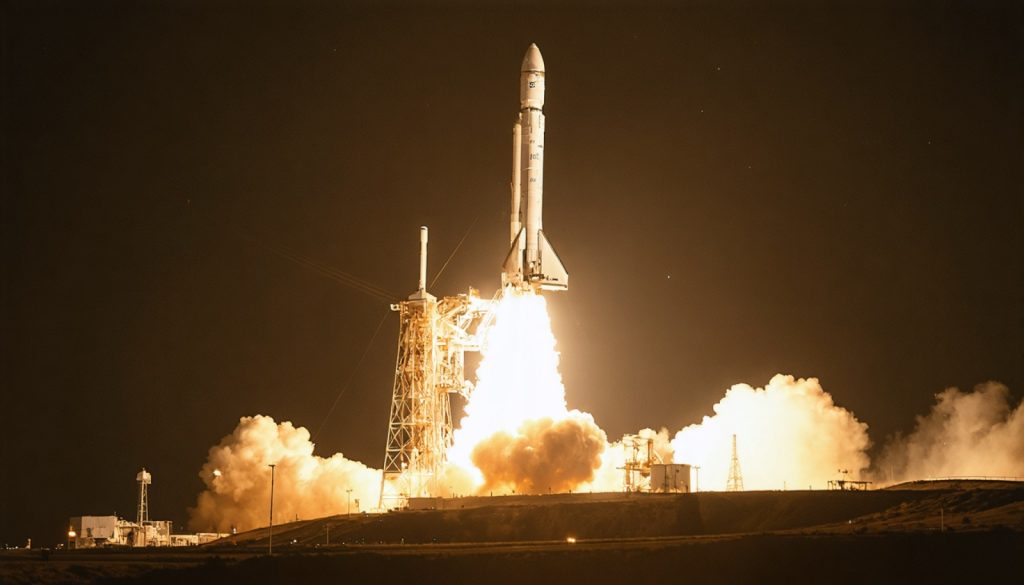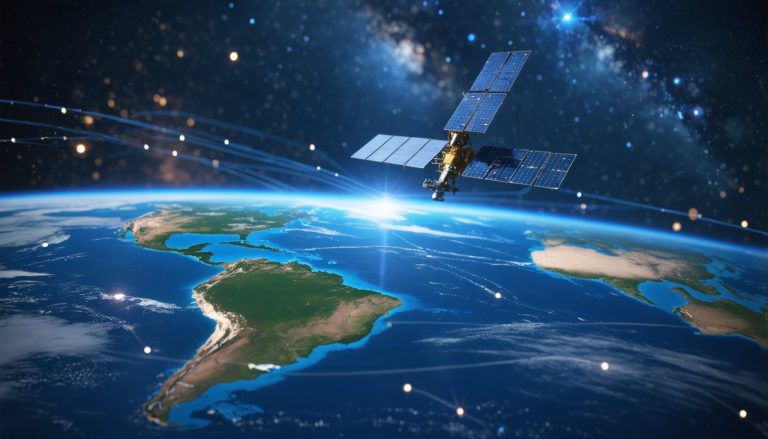
- SpaceX’s Falcon 9 rocket successfully launched Starlink satellites, expanding global internet coverage.
- The mission highlights Elon Musk’s vision for affordable, reliable, and reusable space travel technology.
- Falcon 9’s first stage achieved a flawless landing on a drone ship, showcasing SpaceX’s mastery in reusable rockets.
- This development promises enhanced educational and economic opportunities worldwide through improved connectivity.
- The launch underscores SpaceX’s goal to make space exploration accessible to all, steering humanity toward an interplanetary future.
- Social media buzzes with excitement and stunning photographs, celebrating human ingenuity and exploration spirit.
- Witnessing such events in person inspires a deeper appreciation for innovation and our potential to transcend boundaries.
- SpaceX is crafting a new era, inviting participation in the cosmic journey beyond our Earthly limits.
A plume of fire cuts through the chilly Florida night as SpaceX’s Falcon 9 rocket ascends with precision and vigor, leaving Earth behind in a trail of awe and anticipation. At Cape Canaveral, spectators gather, eyes wide, captivated by this modern marvel. The countdown reaches zero, and the rocket unleashes a burst of brilliance, lighting up the night and resonating with the distant hum of the ocean.
SpaceX, the brainchild of innovator and entrepreneur Elon Musk, once again propels the boundaries of human exploration. Launching an array of Starlink satellites into Earth’s orbit, the mission aims to expand global internet coverage, paving the way for high-speed connectivity even in the remotest corners of the globe. This groundbreaking development holds enormous potential for educational and economic advancement worldwide.
From liftoff to landing, the Falcon 9 executes its routine with surgical accuracy. It’s a testament to SpaceX’s relentless pursuit of reusable technology — the rocket’s first stage returns to land with a smooth vertical touchdown on the drone ship stationed miles off the Atlantic coast. Cheers erupt from the SpaceX mission control center as yet another successful mission adds to their growing legacy.
The implications of tonight’s launch ripple far beyond the immediate spectacle. SpaceX is not only pushing the envelope of what is technically conceivable but is relentlessly pursuing a vision where space is accessible to all. By dramatically cutting costs and enhancing the reliability of space travel, SpaceX is steering humanity toward an interplanetary future.
Engagement and excitement shimmer across social media platforms too. Enthusiasts and professionals alike share dazzling photographs of the launch, capturing the very essence of human ingenuity and the indomitable spirit of exploration.
For those fortunate enough to witness these launches firsthand, they inspire a profound appreciation for our place in the universe. They remind us of our potential to reach beyond current horizons, to innovate relentlessly, and to dream boundlessly.
As the glow of the rocket fades into the night sky, the takeaway becomes clear: SpaceX is not just launching rockets; it is launching humanity into a new era of possibility. This compelling blend of science and spectacle invites each of us to imagine our role in this grand cosmic journey.
SpaceX’s Vision: Transforming Space Travel and Global Connectivity
Expanding Horizons: The Broader Impact of SpaceX’s Latest Launch
SpaceX’s Falcon 9 launch from Cape Canaveral is not merely an awe-inspiring night spectacle; it signifies a bold step forward in satellite technology and space exploration. By deploying a constellation of Starlink satellites, SpaceX aims to provide worldwide high-speed internet access, revolutionizing how remote regions connect with the world.
The Technological Mastery Behind Falcon 9
1. Reusability and Cost-Efficiency
One of SpaceX’s revolutionary contributions is the reusability of its rockets. The Falcon 9’s first stage, designed for multiple launches, reduces costs significantly, making space missions economically viable. This aspect of reusable technology is critical in lowering the barrier to space access and democratizing space travel.
2. Precision Landing Technology
The ability of the Falcon 9 to land vertically on a drone ship is a testament to SpaceX’s advanced engineering capabilities. This precise recovery process ensures rapid turnaround times, essential for maintaining the cadence of launches needed for deploying a vast satellite network.
Real-World Use Cases and Impacts
1. Global Internet Accessibility
The Starlink satellites are expected to blanket the Earth with internet coverage. This holds transformative potential for education and economic growth, particularly in remote areas lacking infrastructure. Students can access global resources, while entrepreneurs can connect to international markets, fostering local innovation.
2. Emergency Communication Networks
In disaster-stricken zones where conventional communication lines are severed, Starlink can provide critical connectivity, ensuring that aid agencies and local governments coordinate effectively and that affected communities receive timely support.
Market Forecasts and Industry Trends
Increasing Demand for Satellite Internet Services
The growth in satellite-based internet services is projected to soar. According to a report by Market Research Future, the global satellite internet market is expected to experience a compound annual growth rate (CAGR) of 8.35% from 2022 to 2030, driven by the need for high-speed internet in developing regions and underserved rural areas.
Pros and Cons Overview
Pros:
– Wide accessibility to high-speed internet.
– Cost-effective launches facilitate frequent satellite deployment.
– Reusable technology promises a sustainable space industry.
Cons:
– Possible environmental concerns regarding space debris.
– Initial high cost may limit immediate adoption for some users.
Controversies and Limitations
Space Debris Concerns
As the number of satellites grows, so does the risk of space debris, which can pose a hazard to other spacecraft and future missions. Strategies for sustainable space operations must be prioritized to mitigate these risks.
Astronomical Observations
Astronomers have raised concerns about satellites reflecting sunlight, potentially interfering with ground-based astronomical observations. SpaceX is working to resolve these issues by implementing coatings and altering satellite orientations.
Actionable Recommendations
– For Observers: Utilize mobile apps like Heavens-Above to track upcoming launches and witness these remarkable events.
– For Technophiles: Consider the benefits of adopting Starlink for a reliable and fast internet connection, especially if residing in a remote location.
– For Investors: Explore opportunities within the rapidly growing satellite internet market, assessing companies that innovate sustainably.
Engage with Space X Activities
For more information and updates on SpaceX’s missions and technological advancements, visit the official SpaceX website.
This latest Falcon 9 launch not only marks another successful mission for SpaceX but represents a pivotal moment in the ongoing saga of humanity’s journey into space. As SpaceX continues to push boundaries, the sky is no longer the limit; it is just the beginning.



